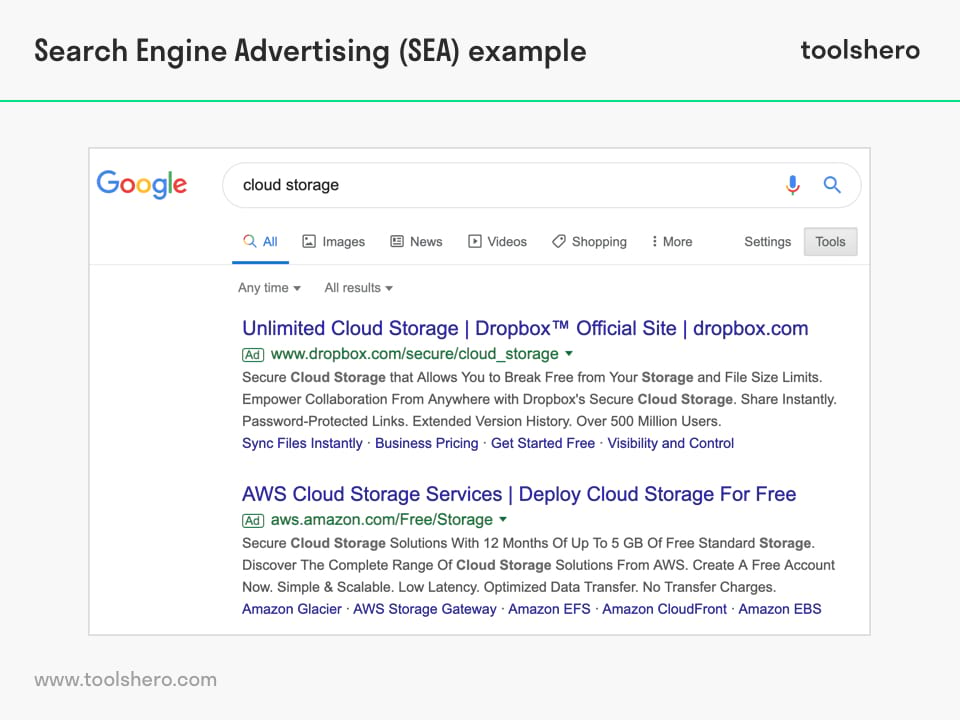Search Engine Advertising (SEA)

Search Engine Advertising (SEA): this article provides a practical explanation of Search Engine Advertising (SEA). After reading, you’ll understand the basics of this powerful marketing tool.
What is Search Engine Advertising (SEA)?
Search Engine Advertising (SEA) is a part of online marketing. This form of advertising involves placing ads on search engines like Yahoo or Google in the form of text or images.
It’s an important revenue stream for search engines. For organisations, advertising via search engines is a cost-effective way to increase their brand recognition. One advantage of advertising via search engines compared to traditional advertising is that the ad is carefully targeted to a relevant audience.
With Search Engine Advertising (SEA), the ads are shown directly in the search engine result page (SERP). They are paid for using methods like pay per click (CPC), or pay per mille (PPM). The ads are relevant because they are selected based on the keywords that were entered. The same ad service also manages ads on other websites.
Ads on the Internet became widespread around 1997. Search engine GoTo was the first one to show sponsored search ads in 2001. Google followed suit a year later by placing Search Engine Advertisements (SEA).
Keywords in Search Engine Advertising (SEA)
Search engine ads are shown based on keywords. These are the words users enter into the search engine. This is also referred to as targeting. The accuracy has led to search engine advertisement (SEA) having become immensely popular among advertisers. Consumers also use search engines to compare product offers, for instance. The search engine that then places ads tailored to their choice will get more clicks.
In many cases, the sponsored search results are also the ones that match the user’s query. This encourages consumers to click on these ads instead of the unpaid results.
Profit potential
Search engines have online auctions where ads are sold. The price is determined based on bids for certain keywords and the relevancy of the keywords for ads in the system.
An important aspect is the profit potential of the keywords. The user enters one or more keywords, which have different profit potential. For instance, the profit potential of a keywords is bigger when someone is looking for ‘micro-loans’ than if the keyword is ‘used bike’. This plays a significant role in the bids by advertisers for specific keywords.
Online search engine advertisers (SEA), such as Google Adwords, let advertisers choose if they want their ads to be displayed on websites, in search results, or both. Bids on ads in the search engine page results (SERP) are generally higher than those for ads on websites.
Online Marketing and quality score
As we explained, advertising through search engines is based on an auction system where advertisers bid on certain keywords that are relevant for their market. This selection of keywords determines for which search queries the ads are shown. Because there are multiple advertisers wanting to advertise the same things, prices go up quickly. The level of competition for certain keywords is indicated with CPC (cost per click).
A competitive offer of the advertising for the keywords is therefore important, but this isn’t the only requirement for the ad. The overall condition of an ad is shown as the quality score. The quality score is based on, among other things:
Keyword relevance
Ad relevance measures the level to which the keyword actually relates to the ads. Generally, relevance is labelled above average, average, and below average. A below-average score means either the ad or the keyword aren’t specific enough.
It’s possible that the ad platform shows a high quality score for a certain ad and keyword, but its relevance is low. That’s because these ad brokers look at a variety of factors. In addition to keyword relevance, they also measure the landing page experience and expected click rate.
Expected Click-through-rate
This quality factor in Search Engine Advertising (SEA) helps to identify keywords that might not be relevant enough to do well. The expected click-through-rate predicts whether a keyword will lead to a user actually clicking on one of the ads. It looks at how well the keyword performed in the past.
The expected click-through-rate (CTR) is an estimate, and differs per medium that is being used (smartphone, desktop, etc.).
Landing page
A website’s landing page experience is a way to measure how well visitors are able to find what they are looking for after clicking on one of the ads. The experience is measured using analyses of automated systems and human evaluation. The experience influences the position of the ad, the CPC, and the advertiser’s position in ad auctions.
Measuring Search Engine Advertising costs
Online ad services, such as Google Adwords, can charge fees to advertisers who want to advertise directly in the search engine results in different ways. Below, we’ve explained the most common ones.
Cost per thousand viewers (CPM)
Cost per thousand, or cost per mille, is a term that’s used to indicate the price of an ad being shown a thousand times on a page.
Cost-per-action (CPA)
Cost per action is a pricing method for ads where the advertiser will only pay if there’s a specific acquisition, such as a sale, click, or contact request. CPA is an effective way to buy ads because the advertiser only pays for an ad once it has had its desired effect. For affiliate marketing that means affiliates only pay for leads that lead to, for example, a sale.
Cost-per-click (CPC)
Cost per click is about paying for clicks by visitors. The advertiser will pay a certain amount for each visitor who clicks on their ad and is directed to their website.
Goals of Search Engine Advertising
Search Engine Advertising (SEA) is used by local businesses as well as large international companies for a variety of reasons.
Generating traffic
The main reason to place ads in the direct search results of search engines is to direct a new stream of visitors to a certain website. Search Engine Advertising is therefore primarily a source of website traffic. Whether a certain ad is actually shown at the top of the list of paid results, depends on the battle for that spot. This battle is decided based on quality and relevance, as well as other things. However, first place can also be assured by placing a high bid in the ad auctions.
Search Engine Advertising to improve brand recognition
The use of search engine advertising is an effective marketing medium to increase brand awareness.
Search Engine Advertising to boost conversions
The primary goal of search engine advertising is acquiring new customers (leads) or increasing sales. Ad platforms show website owners exactly how often ads lead to conversions. This level of effectiveness can be improved by creating specific ads for a certain product or service and improving the landing page experience.
Search Engine Advertising (SEA) summary
Search Engine Advertising offers website owners the option to place ads that will lead directly to their page, making it easier for potential customers to find the products they are looking for. It’s important that the ad text and landing page match closely.
This is indicated using several factors that together make up the quality score. It’s defined as the landing page experience. The expected click-through-rate is also important. This is the expected number of times that viewers will click on the ads to be taken to the landing page. The expected click-through-rate is based on keyword relevance and past performance data.
Advertising platforms can charge advertisers in various ways. Some frequently used methods are: a certain amount per thousand views (cost per mille), cost per action, and cost per click.
Now It’s Your Turn
What do you think? Are you familiar with the explanation of Search Engine Advertising (SEA)? Do you often see ads in your search results? What other online marketing topics would you like to learn more about? Do you have any tips or additional comments?
Share your experience and knowledge in the comments box below.
More information
- Ghose, A., & Yang, S. (2009). An empirical analysis of search engine advertising: Sponsored search in electronic markets. Management science, 55(10), 1605-1622.
- Goldfarb, A., & Tucker, C. (2011). Search engine advertising: Channel substitution when pricing ads to context. Management Science, 57(3), 458-470.
- Joshi, A., & Motwani, R. (2006, December). Keyword generation for search engine advertising. In Sixth IEEE International Conference on Data Mining-Workshops (ICDMW’06) (pp. 490-496). IEEE.
- Yao, S., & Mela, C. F. (2011). A dynamic model of sponsored search advertising. Marketing Science, 30(3), 447-468.
How to cite this article:
Janse, B. (2019). Search Engine Advertising (SEA). Retrieved [insert date] from toolshero: https://www.toolshero.com/marketing/search-engine-advertising-sea/
Published on: 12/12/2019 | Last update: 26/04/2022
Add a link to this page on your website:
<a href=”https://www.toolshero.com/marketing/search-engine-advertising-sea/”>toolshero: Search Engine Advertising (SEA)</a>













